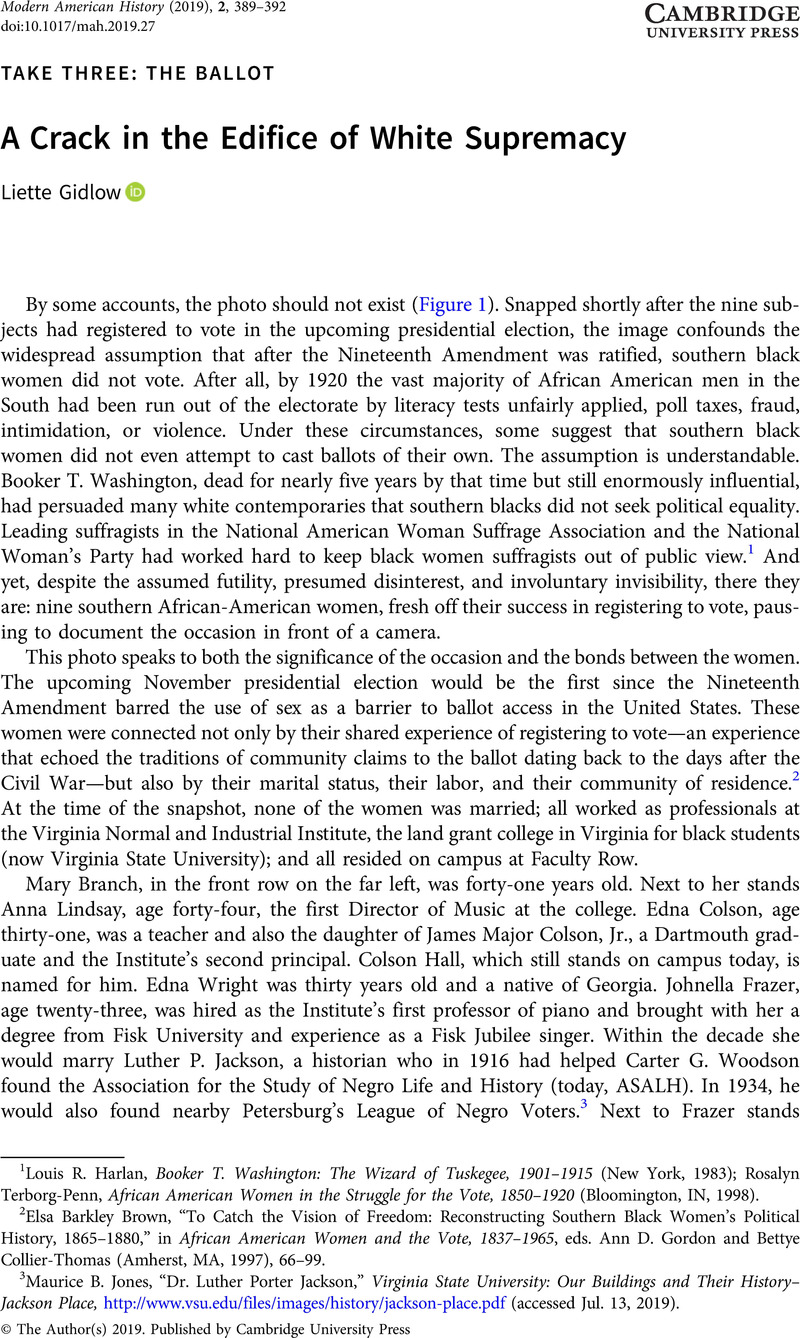No CrossRef data available.
Article contents
A Crack in the Edifice of White Supremacy
Published online by Cambridge University Press: 09 December 2019
Abstract

- Type
- Take Three: The Ballot
- Information
- Copyright
- Copyright © The Author(s) 2019. Published by Cambridge University Press
References
1 Harlan, Louis R., Booker T. Washington: The Wizard of Tuskegee, 1901–1915 (New York, 1983)Google Scholar; Terborg-Penn, Rosalyn, African American Women in the Struggle for the Vote, 1850–1920 (Bloomington, IN, 1998)Google Scholar.
2 Brown, Elsa Barkley, “To Catch the Vision of Freedom: Reconstructing Southern Black Women's Political History, 1865–1880,” in African American Women and the Vote, 1837–1965, eds. Gordon, Ann D. and Collier-Thomas, Bettye (Amherst, MA, 1997), 66–99Google Scholar.
3 Maurice B. Jones, “Dr. Luther Porter Jackson,” Virginia State University: Our Buildings and Their History–Jackson Place, http://www.vsu.edu/files/images/history/jackson-place.pdf (accessed Jul. 13, 2019).
4 Gidlow, Liette, “The Sequel: The Fifteenth Amendment, the Nineteenth Amendment, and Southern Black Women's Struggle to Vote,” Journal of the Gilded Age and Progressive Era 17, no. 3 (July 2018): 433–49CrossRefGoogle Scholar.
5 Quoted in McRae, Elizabeth Gillespie, “Caretakers of Southern Civilization: Georgia Women and the Anti-Suffrage Campaign, 1914–1920,” Georgia Historical Quarterly 82, no. 4 (Winter 1998): 801–28Google Scholar, here 828, n52.
6 Johnson, Kenneth R., “White Racial Attitudes as a Factor in the Arguments against the Nineteenth Amendment,” Phylon 31, no. 1 (1970): 31–7CrossRefGoogle Scholar, here 32.
7 Quoted in Wheeler, Marjorie Spruill, New Women of the New South: The Leaders of the Woman Suffrage Movement in the Southern States (New York, 1993), 128Google Scholar.
8 Quoted in Johnson, “White Racial Attitudes,” 33.
9 Johnson, “White Racial Attitudes,” 35.
10 Ibid., 36.
11 Liette Gidlow, “Resistance After Ratification: The Nineteenth Amendment, African American Women, and the Problem of Female Disfranchisement after 1920,” Women and Social Movements in the U.S., 1600–2000 21, no. 1 (March 2017) http://asp6new.alexanderstreet.com/tinyurl/tinyurl.resolver.aspx?tinyurl=1HAV8.
12 Gilmore, Glenda E., “The 2008 Election, Black Women's Politics, and the Long Civil Rights Movement,” in Obama, Clinton, Palin: Making History in Election 2008, ed. Gidlow, Liette (Urbana, IL, 2011), 55–65Google Scholar, here 59.
13 Lawson, Steven F., Black Ballots: Voting Rights in the South, 1944–1969 (Lanham, MD, 1999), 331Google Scholar.
14 Behrens, Angela, Uggen, Christopher, and Manza, Jeff, “Ballot Manipulation and the ‘Menace of Negro Domination’: Racial Threat and Felon Disenfranchisement in the United States, 1850–2002,” American Journal of Sociology 109, no. 3 (Nov. 2003): 559–605CrossRefGoogle Scholar.
15 “Trends in Party Affiliation Among Demographic Groups,” Pew Research Center, Mar. 20, 2018, https://www.people-press.org/2018/03/20/1-trends-in-party-affiliation-among-demographic-groups/ (accessed Aug. 5, 2019).
16 Yvonne Scruggs-Leftwich, “Significance of Black Women's Vote Ignored,” Womens eNews, Nov. 15, 2000, https://womensenews.org/2000/11/significance-black-womens-vote-ignored/ (accessed Apr. 14, 2019).
17 Vanessa Williams, “Black Women Vow to Be a Powerful Voting Force Again This Year,” Washington Post, Jan. 10, 2016, https://www.washingtonpost.com/politics/black-women-vow-to-be-a-powerful-voting-force-again-this-year/2016/01/10/f0c290fc-b324-11e5-a842-0feb51d1d124_story.html (accessed Aug. 28, 2019).


